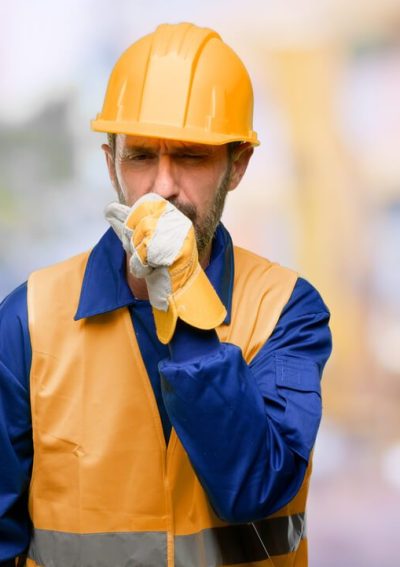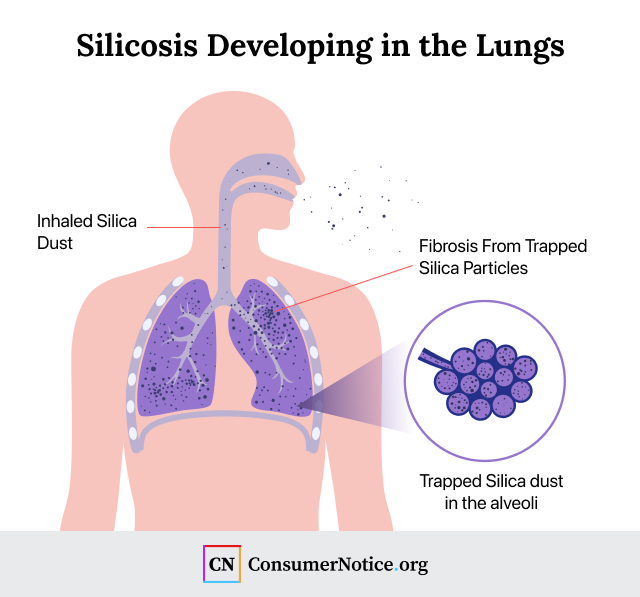Silicosis
Silicosis is an incurable and debilitating lung disease primarily caused by occupational exposure to respirable crystalline silica. Some of the earliest silicosis symptoms include breathing difficulties, wheezing and chest tightness. The disease may take years to manifest but can be fatal.

What Is Silicosis?
Silicosis is an occupational lung disease that occurs after inhaling crystalline silica particles. Silicosis symptoms include coughing, inflammation and fibrosis. Though symptoms may not manifest for years, some people begin experiencing them within weeks of high exposure levels. The disease is incurable and debilitating and often leads to death.
The defining characteristic of silicosis is the presence of fibrous, rounded nodules that tend to form on the upper lobes of the lungs. The fibrous nodules may also appear in the lymph nodes, either in the presence of pulmonary nodules or in isolation.

Silica is a naturally occurring substance found in certain types of sand, clay and rock. However, many construction materials, ceramics and industrial sand contain crystalline silica particles, including mortar and concrete.
Workers in the construction, mining, steelworking and extraction industries are among those most at risk. Whether a worker develops silicosis depends on several factors, including the concentration of crystalline silica in the inhaled material, particle size and exposure duration.
Types of Silicosis
There are three types of silicosis, differentiated by exposure level and latency period. Silicosis symptoms can also vary. The three types are:
- Chronic: This is the most common form of the disease, occurring after more than 10 years of exposure and leading to decreased lung function and lung and lymph node inflammation.
- Accelerated: This form of silicosis occurs with more intense exposure levels over a shorter period of time — generally three to 10 years — and causes symptoms similar to chronic silicosis.
- Acute: The rarest type of this disease, acute silicosis, results after short-term exposure to high concentrations of crystalline silica and leads to more severe symptoms.
Though severity can vary between individuals, all three types tend to lead to severe disease and debilitating symptoms. All forms of silicosis are progressive, leading to worsening conditions.
What Causes Silicosis?
The primary causes of silicosis are inhaling crystalline silica in high concentrations over a short duration or in lower concentrations over a long period. The particles must be airborne and small enough for a person to breathe them into the lungs. Exposure to silica dust in the workplace is the most significant contributing factor.
Inhaled particles make their way into the lungs and become lodged in the tissues, which causes chronic inflammation and an overactive immune response. The damage leads to the formation of the fibrous nodules that characterize the disease.
Though the cause of silicosis is not in doubt, millions of workers worldwide continue to be at risk. The Global Burden of Disease study identified 23,695 cases of silicosis globally in 2017. In 2019, the GBD study found that more than 12,900 people died from silicosis. The disease is preventable with the use of appropriate safety gear. However, every year new cases arise and more deaths occur.
Who Is at Risk of Developing Silicosis?
Those who work with materials that contain respirable crystalline silica without adequate protection are most at risk of developing silicosis. Furthermore, wearing and keeping dusty work clothes in the home increases exposure and risk by as much as 10%, according to one U.S. Bureau of Mines report.
- Building construction workers
- Civil engineers
- Dentists and dental technicians
- Farmers
- Foundry workers
- Hydraulic fracturing workers
- Masonry workers
- Manufacturers of glass, pottery, ceramics, bricks, concrete and quartz countertops
- Miners
- Oil and gas workers
- Quarry workers
- Road construction workers
- Rock drillers
- Sandblasters
- Stonecutters
Anyone whose job involves participating in or being around the blasting, crushing, drilling, breaking, sanding, grinding or milling of materials containing respirable crystalline silica is at risk of silicosis. Silica dust is not always visible and workers cannot count on dust visibility as a risk indicator.
Silicosis Symptoms and Signs
The early stages of silicosis might not cause symptoms. However, as it progresses, those with the disease usually begin noticing signs such as shortness of breath, chest tightening, severe coughing and wheezing. Other silicosis symptoms and signs include:
- Blue lips
- Breathing difficulty or breathlessness
- Chest pain
- Chronic, nagging cough
- Fatigue
- Fever
- Fluid in the lungs
- Low blood oxygen
- Lung scarring
- Night sweats
- Reduced lung capacity
- Shortness of breath with exercise
- Swelling in the lungs and chest lymph nodes
- Swollen legs
- Weakness and fatigue
- Weight loss
Not all people who have silicosis will experience every symptom. The type of silicosis and severity of the disease can lead to varying health impacts. However, symptoms often worsen over time as the disease progresses.
Diagnosing Silicosis
Diagnosis of silicosis is challenging, as most available tools cannot detect early signs of the disease. Furthermore, the potentially lengthy latency period and a physician’s inability to identify silicosis among multiple potential occupational lung diseases create further challenges in diagnosis.
- Chest X-rays
- Health and exposure questionnaires
- High-resolution computed tomography
- Pulmonary function tests
According to a 2023 study published in the International Journal of Molecular Sciences, clinicians should avoid performing lung biopsies due to the potential for adverse impacts. However, when environmental exposure is lacking or discrepancies exist between chest X-rays and high-resolution imaging, a biopsy is the only way to diagnose the disease accurately.
Silicosis Treatment
Treatment for silicosis, which has no cure, primarily aims to manage symptoms and extend and improve quality of life. Experimental treatment methods include cleansing the lungs using a saline solution, drug treatment with pirfenidone and nintedanib, and traditional Chinese herbal medicines. Exercise can also improve lung capacity and function and enhance the quality of life for patients. Lung transplant is a possibility for those in late-stage silicosis.
Research on silicosis treatment options is ongoing. There are promising new drugs, but no large, placebo-controlled clinical trials to determine drug efficacy, safety or side effects. Future treatment options may rely on advanced technologies and a multitargeted approach.
How Long Can You Live With Silicosis?
How long a person lives with silicosis depends on individual factors, such as age of onset, exposure duration, smoking habits and overall health. Disease factors also impact prognosis, including the type of silicosis and the disease stage when detected.
The survival times of silicosis stage I, II and III, from the year of diagnosis to death, have been reported to be about 21.5, 15.8 and 6.8 years, respectively. Studies found a relationship between age of onset, years of exposure, disease progression speed and economic status, which all impacted the length of time a patient survived silicosis.
Is Silicosis Preventable?
Yes, silicosis is preventable. Employers are responsible for providing employees with safe working conditions that follow Occupational Safety and Health Administration guidelines. Failure to ensure a safe working environment increases workers’ silicosis risk. Employees should adhere to safety guidelines and protocols to protect themselves from exposure.
- Implementing, maintaining and using dust control technologies and engineering controls
- Monitoring air quality conditions and mitigating poor quality when necessary
- Substituting respirable crystalline silica materials with less hazardous ones
- Providing, maintaining and using approved particulate respirators when necessary
- Practicing good personal hygiene and changing clothing before leaving the worksite
Employers should also provide regular training on crystalline silica safety and silicosis and offer health screenings when exposure occurs. Preventative measures include environmental controls that eliminate airborne particulates, training, personal safety gear and worksite behaviors.
The burden of establishing these measures rests with the employer. Those exposed to respirable crystalline silica and diagnosed with silicosis within the past five years may be eligible to file a silicosis lawsuit.
14 Cited Research Articles
Consumernotice.org adheres to the highest ethical standards for content production and references only credible sources of information, including government reports, interviews with experts, highly regarded nonprofit organizations, peer-reviewed journals, court records and academic organizations. You can learn more about our dedication to relevance, accuracy and transparency by reading our editorial policy.
- NIOSH. (2023, July 11). Health Risks of Silica Exposure and Medical Monitoring. Retrieved from https://www.cdc.gov/niosh/topics/silica/risks.html
- Li, R., Kang, H. & Chen, S. (2023, May 05). From Basic Research to Clinical Practice: Considerations for Treatment Drugs for Silicosis. Retrieved from https://www.mdpi.com/1422-0067/24/9/8333
- NIOSH. (2023, April 26). Study Syllabus for Classification of Radiographs of Pneumoconioses. Retrieved from https://www.cdc.gov/niosh/learning/b-reader/pathology/silicosis/1.html
- Mlika, M., Adigun, R. & Bhutta, B.S. (2023, February 9). Silica-Induced Pneumoconiosis. Retrieved from https://www.ncbi.nlm.nih.gov/books/NBK537341/
- Xiu, J.N. et al. (2022, October 20). Investigation on dust pollution and pneumoconiosis incidence in a steel enterprise. Retrieved from https://pubmed.ncbi.nlm.nih.gov/36348553/
- Song, X. et al. (2022, July 28). Survival analysis of 15,402 pneumoconiosis cases in Jiangsu Province of China from 1961 to 2019. Retrieved from https://apm.amegroups.org/article/view/92642/html
- Chen, S., Lieu, M. & Xie, F. (2022, June 21). Global and national burden and trends of mortality and disability-adjusted life years for silicosis, from 1990 to 2019: results from the Global Burden of Disease study 2019. Retrieved from https://bmcpulmmed.biomedcentral.com/articles/10.1186/s12890-022-02040-9
- Li, T. et al. (2022, April 25). Early Identification, Accurate Diagnosis, and Treatment of Silicosis. Retrieved from https://www.hindawi.com/journals/crj/2022/3769134/
- Hoy, R.F. et al. (2022, March 18). Current global perspectives on silicosis—Convergence of old and newly emergent hazards. Retrieved from https://onlinelibrary.wiley.com/doi/10.1111/resp.14242
- NIOSH. (2014, June 06). Preventing Silicosis and Deaths From Sandblasting. Retrieved from https://www.cdc.gov/niosh/docs/92-102/default.html
- CDC. (n.d.). Clothes Cleaning Process. Retrieved from https://www.silica-safe.org/training-and-other-resources/manuals-and-guides/asset/NIOSH_mining_Clothes-Cleaning-Process.pdf
- CDC. (n.d.). Silicosis: Learn the Facts! Retrieved from https://www.cdc.gov/niosh/docs/2004-108/pdfs/2004-108.pdf?id=10.26616/NIOSHPUB2004108
- OSHA. (n.d.). Silica, Crystalline. Retrieved from https://www.osha.gov/silica-crystalline
- USDL. (n.d.). Tips for Preventing Silicosis: If It’s Silica, It’s Not Just Dust. Retrieved from https://www.msha.gov/sites/default/files/Alerts%20and%20Hazards/HH%20Cards/HH-7%20Tips%20for%20Preventing%20Silicosis.pdf
Calling this number connects you with a Consumer Notice, LLC representative. We will direct you to one of our trusted legal partners for a free case review.
Consumer Notice, LLC's trusted legal partners support the organization's mission to keep people safe from dangerous drugs and medical devices. For more information, visit our partners page.
855-842-1699

